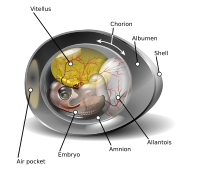
Photo from wikipedia
In insects, the last stage of oogenesis is the process where the chorion layers (eggshell) are synthesized and deposited on the surface of the oocytes by the follicle cells. Protein… Click to show full abstract
In insects, the last stage of oogenesis is the process where the chorion layers (eggshell) are synthesized and deposited on the surface of the oocytes by the follicle cells. Protein homeostasis is determined by the fine‐tuning of translation and degradation pathways, and the ubiquitin–proteasome system is one of the major degradative routes in eukaryotic cells. The conjugation of ubiquitin to targeted substrates is mediated by the ordered action of E1‐activating, E2‐conjugating, and E3‐ligase enzymes, which covalently link ubiquitin to degradation‐targeted proteins delivering them to the proteolytic complex proteasome. Here, we found that the mRNAs encoding polyubiquitin (pUbq), E1, and E2 enzymes are highly expressed in the ovaries of the insect vector of Chagas Disease Rhodnius prolixus. RNAi silencing of pUbq was lethal whereas the silencing of E1 and E2 enzymes resulted in drastic decreases in oviposition and embryo viability. Eggs produced by the E1‐ and E2‐silenced insects presented particular phenotypes of altered chorion ultrastructure observed by high‐resolution scanning electron microscopy as well as readings for dityrosine cross‐linking and X‐ray elemental microanalysis, suggesting a disruption in the secretory routes responsible for the chorion biogenesis. In addition, the ovaries from silenced insects presented altered levels of autophagy‐related genes as well as a tendency of upregulation in ER chaperones, indicating a disturbance in the general biosynthetic‐secretory pathway. Altogether, we found that E1 and E2 enzymes are essential for chorion biogenesis and that their silencing triggers the modulation of autophagy genes suggesting a coordinated function of both pathways for the progression of choriogenesis.
Journal Title: Journal of Cellular Physiology
Year Published: 2022
Link to full text (if available)
Share on Social Media: Sign Up to like & get
recommendations!